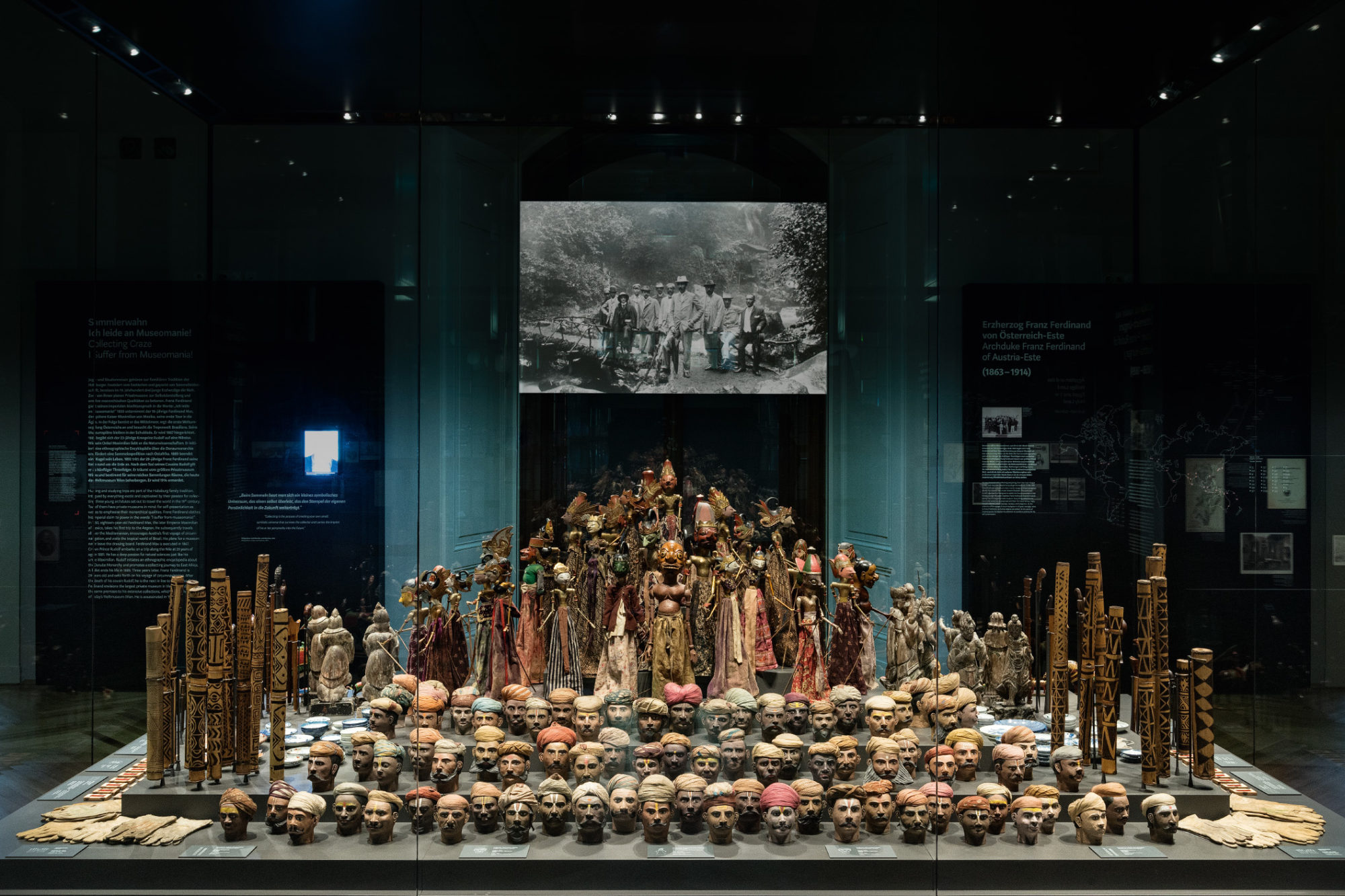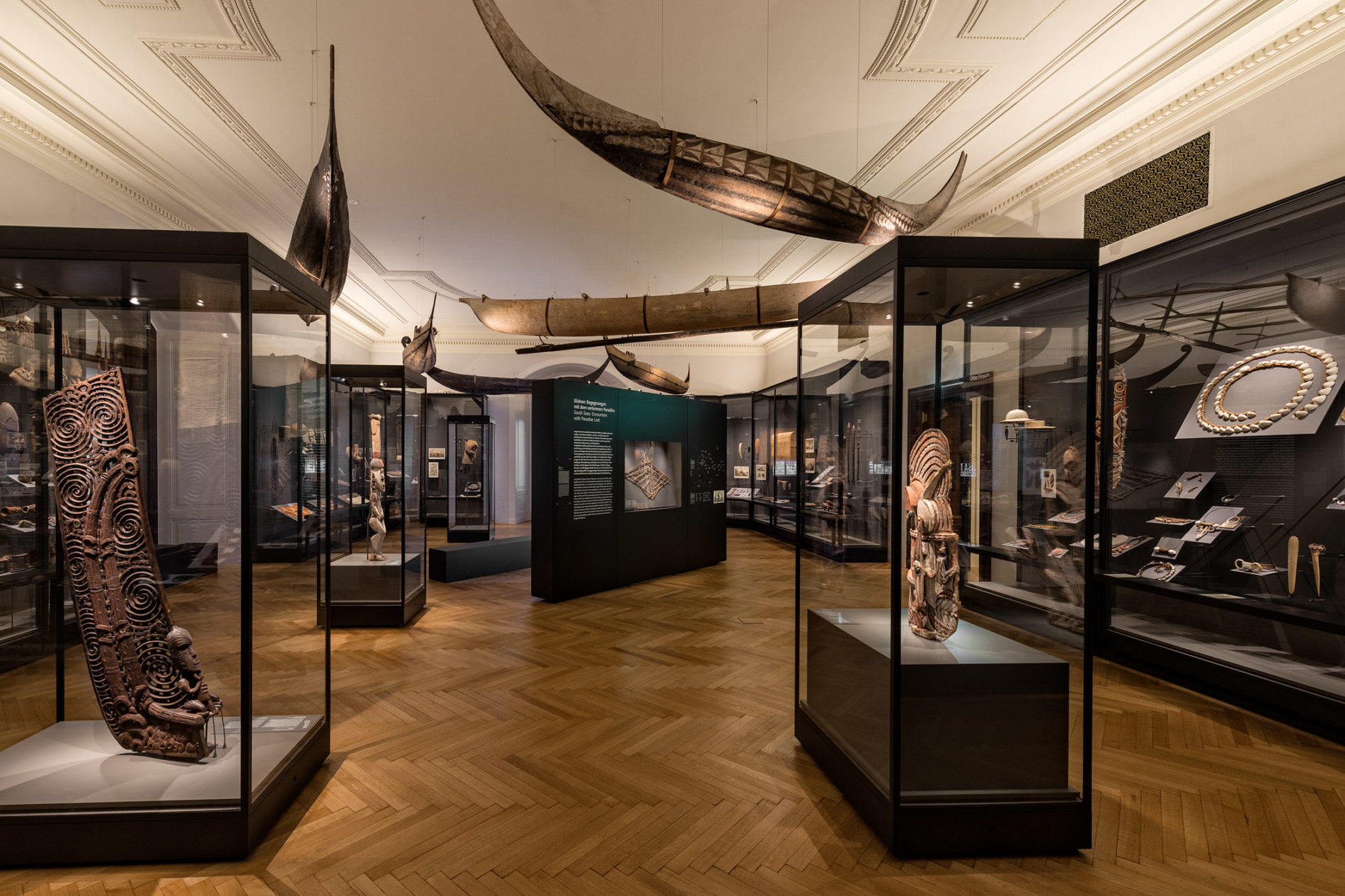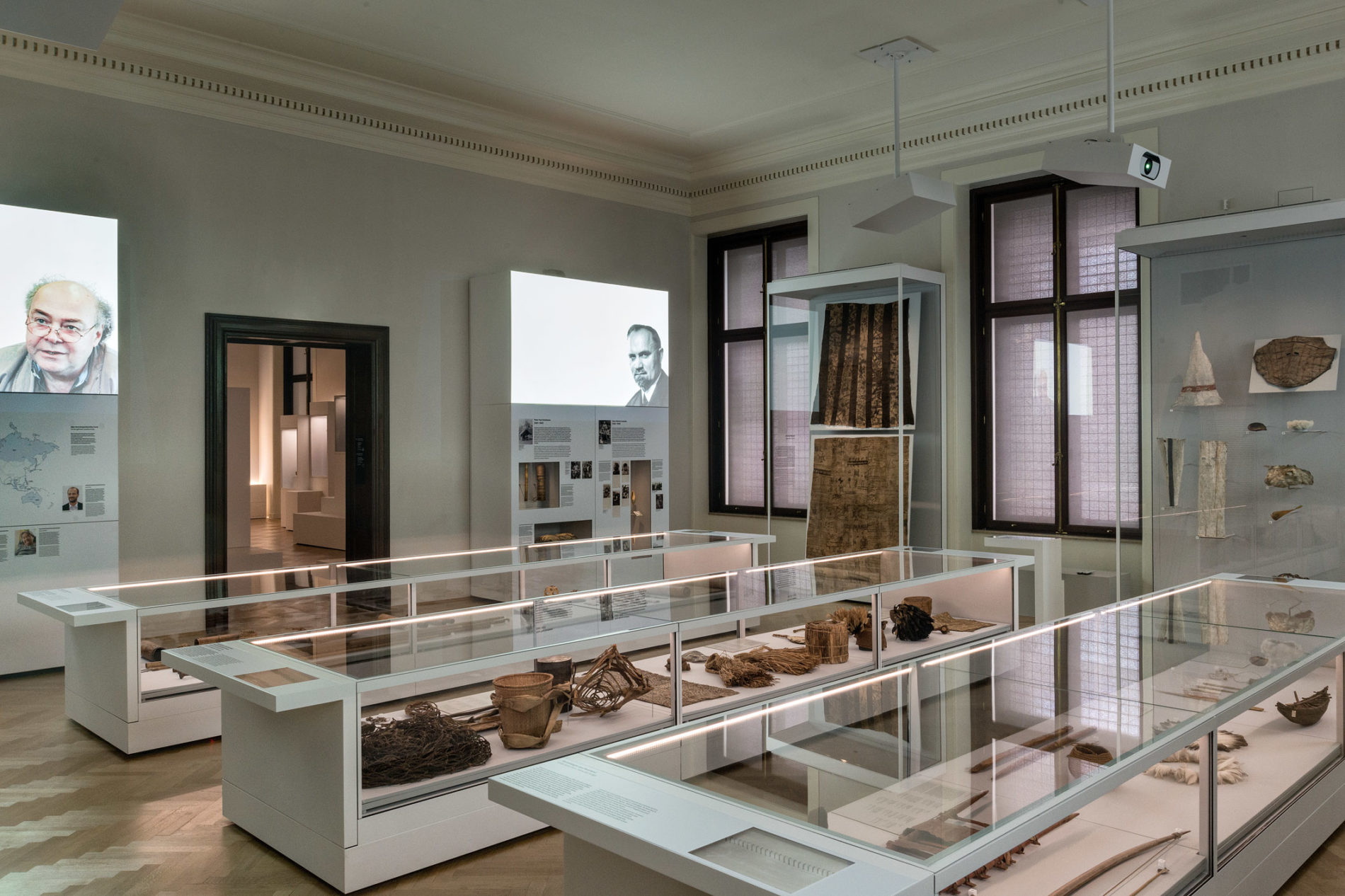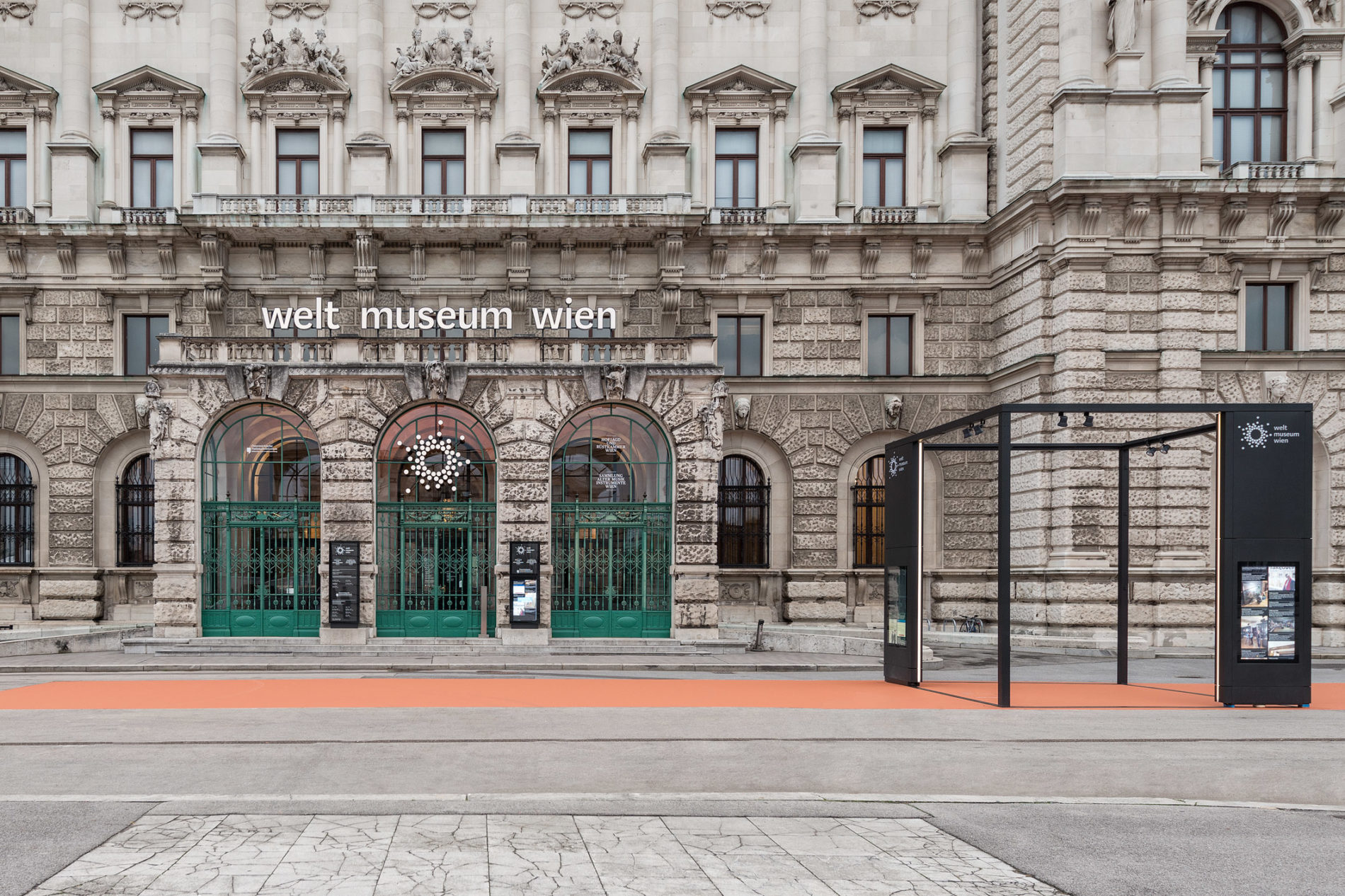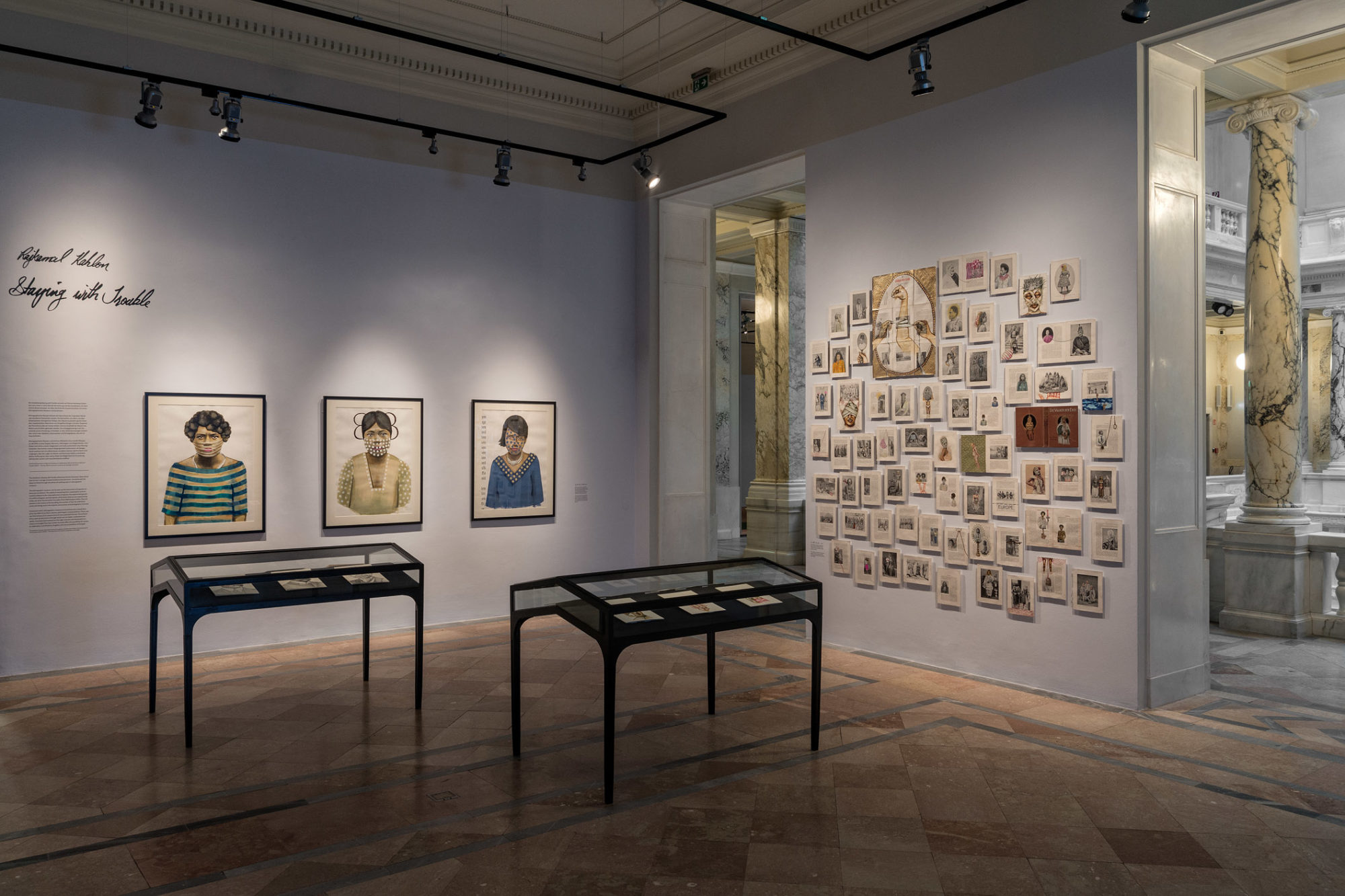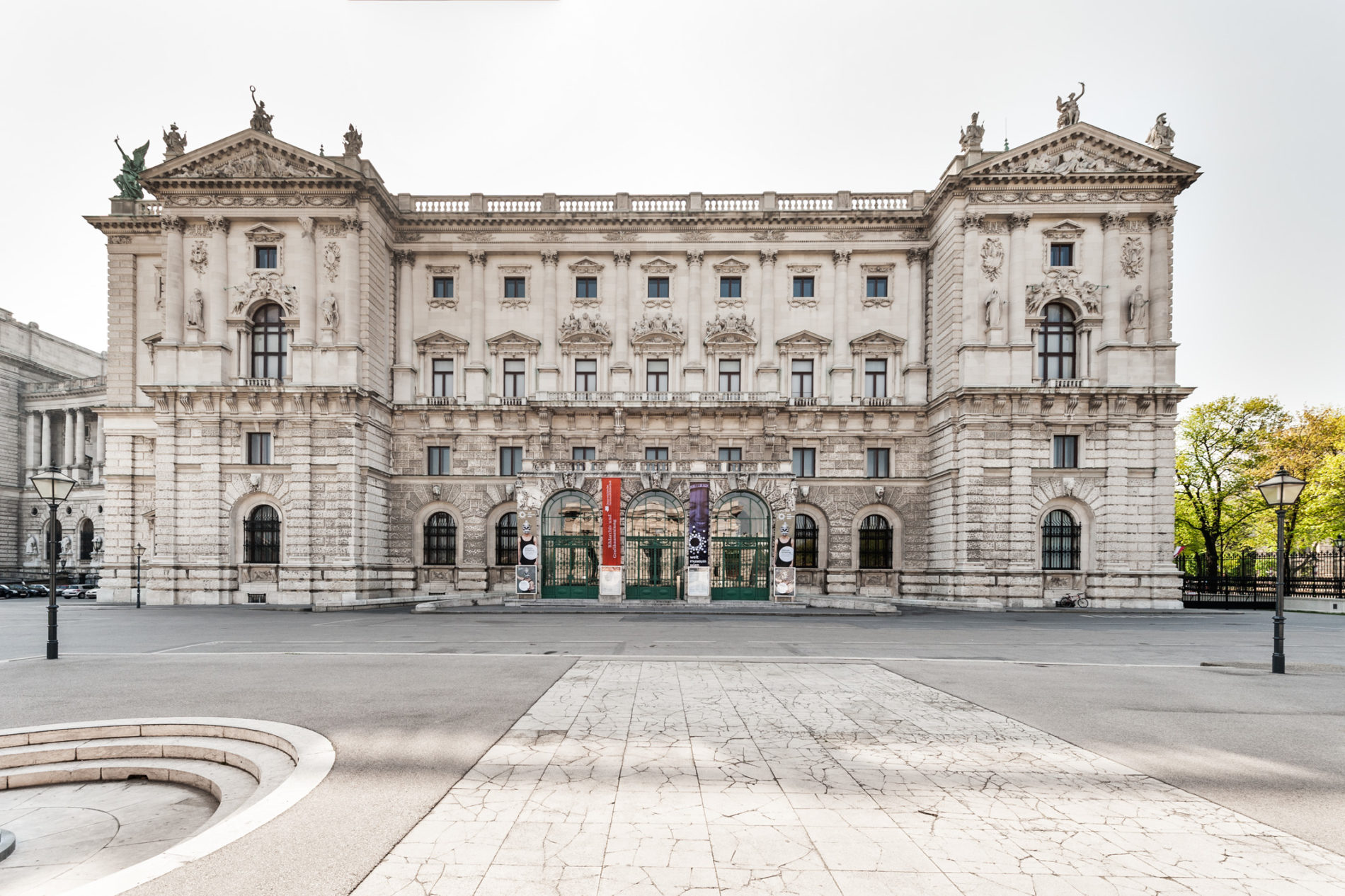
Weltmuseum Wien, view of external façade [Courtesy of the Weltmuseum Wien]
Decolonizing the Ethnographic Museum
Share:
Coinciding with the latest wave of globalization, the museum has again become a site of critique. This wave of criticism does not concern institutions of modern and contemporary art but instead a type of institution whose critical force in narrating Western modernity’s view on its exotic or “pre-modern” Other has somehow long gone uncontested. While the disciplines of anthropology and the once popular “ethnology” underwent a series of paradigm shifts and crises following World War II and the breakup of what remained of the European colonial empires in the second half of the 20th century, the continent’s ethnographic collections were reluctant to reflect these changes. Institutions such as the Weltmuseum Wien—the Vienna “World Museum,” until 2013 called the “Museum of Ethnology” (Museum für Völkerkunde)—claim no longer to adhere to the ordering principles that Western museums and collections have imposed on their objects presented since the 19th century. In addition to renaming, these institutions are rebranding programmatically, shifting their focus away from archives and taxonomies and toward discourse, cross-disciplinary research, and participation—taking a cue, perhaps, from museums of modern and contemporary art, where institutional critique and relational aesthetics began to affect curatorial priorities in the 1990s. Institutions such as Vienna’s Weltmuseum are now building on this legacy.
Central to interrogating the role of the institution in contemporary society is the question of how to contest and deconstruct the notion of history as a teleological model of progress, charted by technology and expansion. This model places both “primitive” cultures—namely, non-Western ones—and their cultural production outside the path of modern history. In this configuration, even as they continue to exist, these cultures’ status of contemporaneity is negated; instead, the non-West is understood as part of a prehistory. The prevailing, Eurocentric historiography—a (Hegelian) history of progress and determinism, which primed the (philosophical) climate for European nationalism—was challenged by philosopher Karl Jaspers’ concept of the “axial period.”1 Writing in the context of post-war Europe, Jaspers designates a pivotal age in the development of thought that he notes to have occurred simultaneously in various parts of the world between 800 BCE and 200 BCE—without these various cultures necessarily having come into contact with one another. Imagining that there are parallel developments in the history of philosophy is one way to expose the chimera of Eurocentric domination.2
Weltmuseum Wien, “South Seas: Encounters with Paradise Lost,” permanent gallery installation view, Grand Reopening (October 2017) [all images courtesy of the Weltmuseum Wien; © KHM-Museumsverband]
Ethnographic museums and anthropological museology were pivotal places of exposure and conversation in the cultural investigations of interwar Europe. (They provided Picasso’s access to the African and Oceanian masks that inspired the physiognomies in his Cubism-catalyzing Les Demoiselles d’Avignon, for example, or so the story goes.) Today, against the backdrop of massive global migration, these former institutions must be active agents in the rewriting of anthropological history, rather than remaining passive storage sites. The Weltmuseum Wien’s rebrand was not the only one to take place the last two decades, during which European institutions such as the Weltkulturen Museum in Frankfurt am Main and the Tropenmuseum in Amsterdam have made changes in the presentation and mediation of their colonial collections, though at times still adhering to their historical principles of ordering and categorization. Museums once named after the explorer-collectors who sponsored them, or the climate zone or geographic region from which their artifacts were taken, have nonetheless become aware of the need to leave the 19th century behind not only in name but also in practice, and to question the very principles of collecting still so deeply embedded with colonialist thought.
Today, the Vienna Weltmuseum’s collection contains half a million ethnographic objects, photographs, and books, grown from the 16th-century collection of Archduke Ferdinand II, which was held in the Chamber of Art and Curiosities at Ambras Castle in Tyrol until the 19th century. Like many state museums in Europe, this royal collection was reorganized as the monarchy was, and it was made available for public consumption in capital cities. (During the French Revolution, for example, the medieval and Early Modern collections that weren’t looted at their former sites were eventually nationalized.) Austria’s universalist cabinets of curiosities and imperial collections were split up, recombined, and merged into thematic exhibition houses—in Vienna, newly built palaces around the Ringstrasse in the city center. Much of the newly reclassified collections were placed in the museums of art history (Kunsthistorisches Museum) and natural history (Naturhistorisches Museum), both opened in 1891 and neighboring each other on the expanded grounds of the Hofburg imperial palace. The Weltmuseum is located in the Hofburg’s so-called Corps de Logis, a three-story side wing of the southwestern arm of the building. One might argue that the centralization of such collections into a neighborhood of museums constitutes a display of the dwindling empire’s will to control the narrative and interpretation of the objects’ history—an assertion of power that represents an attempt to come to terms with the new academic disciplines and scientific forms that were emerging at the time, establishing new principles of order.
The Weltmuseum Wien’s new brand encompasses both the “global” (Welt) and the “local” (Wien) and, hence, expresses in name its understanding that large, global discourse and research and local community and context are equally central to affirming its status as a contemporary postcolonial and post-ethnological institution. An institution having demonstrated leadership in that respect during this decade is the Frankfurt Weltkulturen Museum (The Frankfurt Museum of World Cultures), which with the exhibition Objekt Atlas (January, 26–September 16, 2012) became one of the first spaces to invite contemporary artists into the historical museum. The institution subsequently deployed a comprehensive series of research projects, conversations, and publications relating to and extending beyond the project, including OBJEKT ATLAS: Feldforschung im Museum (OBJECT ATLAS: Field Research in the Museum), dedicated to dialogues between contemporary art and ethnology. The old museum of non-European art and culture had begun to style itself as a self-reflexive catalogue of the global contemporary world.
Weltmuseum Wien, “South Seas: Encounters with Paradise Lost,” permanent gallery installation view, Grand Reopening (October 2017) [© KHM-Museumsverband; courtesy of the Weltmuseum Wien]
In the summer of 2015, when the Weltmuseum Wien was in the middle of a three-year renovation, choreographer Claudia Bosse was invited to take over six galleries on the museum’s mezzanine level. Bosse’s installation-based a second step to IDEAL PARADISE (July 27–August 16, 2015), part of her IDEAL PARADISE series, reorganized the galleries’ content according to different themes, among them “colonialism” and “cultural projection,” and arranged archival documents, photographs, and objects—some items belonging to the artist herself, others to the museum—among the emptied 19th century vitrines. The glass layer that once protected the objects—shielded the visitor from them, creating distance—was removed; stripped of their glass and support structure these cases literally laid bare the dusty wood and outdated textile linings typical of such displays. The artifacts they once contained had been withdrawn from sight and safely stored in the museum’s depots. Transformed into Bosse’s stage set, Vienna’s ethnographic collection ceased to evoke melancholic images of Austria’s imperialist past. Concurrent with her installation at the Weltmuseum, Bosse presented an accompanying performance, a third step to IDEAL PARADISE, as part of Vienna’s international dance festival ImPulsTanz. The narrative created by the work’s performers’ and viewers’ interactions with the imperial space, and the vernacular objects presented within it, pointed to the shift that would come with the 2017 reopening of the museum. Bosse’s intervention suggested that ethnographic artifacts’ entangled histories might be best understood through live, active engagement of individuals within the institution and directed toward it to expose its forceful role in the narration of colonial history. Bosse is not of colonized origin, however; her problematic function as a commissioned artist is in this respect similar to that of the Western curator here: she may highlight the colonial heritage and the postcolonial conversations that must be had in the space to move past that history, but the degree to which she might provide a revolutionary perspective in this context is inherently limited.
In line with this introduction of contemporary performative artistic practice into the formal environment of the Weltmuseum is the institution’s aim to reposition itself and by extension Vienna at large vis-à-vis its perceived role as a culture capital of “old” Europe. To sustain relevance, it must be known as a global city of today, unattached to outdated or academic perceptions of how art can be presented (or what it could be). Bosse’s intervention is one of several intended to demonstrate an institutional awareness that, as a historical agent, the Weltmuseum itself can provide tools to discuss contemporary problematics, both through programming around such themes as migration, neoliberal globalism, and the latest rise of right-wing nationalist ideology, and by rethinking exhibition design and the treatment of objects. The museum now offers a nuanced presentation concept that juxtaposes dark, discreet displays with alternating galleries hosting bright, visitor-oriented zones of information, which provide context by addressing the country’s colonial past; the legacy of the Vienna School of Ethnology; and, in a presentation called “In the Shadow of Colonialism,” Austria’s colonialist entanglements in the global trade of artifacts. The museum’s conceptual aim here is to showcase multiple modes of its engagement—academic, discursive, and object-oriented—enriched and perhaps made accessible to wider audiences by multiple layers of information. “Shelves” accompany many of the vitrines and offer additional information on the conditions under which the artifacts entered the collection, making transparent the object’s acquisition histories and the broader geopolitical conditions of the trade in ethnographic objects.
Weltmuseum Wien, “Culture war in Vienna,” permanent gallery installation view, Grand Reopening (October 2017) [© KHM-Museumsverband; courtesy of the Weltmuseum Wien]
Also addressed in this new presentational format is the question of restitution—a solution still hotly debated within the critical, historical, and conservationist communities. Among the museum’s key objects is the infamous Penacho de Moctezuma, an Aztec feathered headdress that continues to be featured as a main attraction; it appears, for example, on the museum’s pamphlets and printed promotional materials. This headdress’ presence in Vienna is contentious; though the museum has openly discussed certain cases of restitution, it seems for key (or “celebrity”) artifacts, such as this one from Mexico, there are always conservational or other rationalized reasons that they must remain on site.
The mercantile aspects of certain ethnographic objects are also highlighted in the Weltmuseum’s revised design. On display, for example, are so-called Malagan masks from New Guinea, which traditionally are ritually destroyed after use. According to the Weltmuseum literature, however, their creators noted European interest in the objects and started to fabricate and preserve them explicitly for international trade. This narrative both sheds light on the scope and impact of the booming international import/export economy in which the Habsburgs traded, and it illustrates what anthropologist James Clifford has called the “salvage paradigm”: that is, the assumption that Non-Western materials cultures must be “rescued” by the West and housed in Western institutions if there is to be any hope of them being preserved.3 Vienna’s Weltmuseum presents itself as a “world museum” for a “global city,” thus positioning itself as a postcolonial link between imperial modernity and our contemporary era; such models as the salvage paradigm nonetheless endure in that connection.
The institution’s shift from a one-directional object orientation—an exhibit—to a visitor and discourse-oriented platform is intriguing and problematic in equal measure. Mirjam Shatanawi, curator at Amsterdam’s Tropenmuseum, has suggested that if contemporary art is to play a role in the transformation of the ethnographic museum, it must rethink the principles of ordering and classification— otherwise, it risks simply underscoring, perpetuating, or being complicit with them.4 What can contemporary art practices add not only to viewer engagement or topical programs but also to museology as such?
Some museums have sought to extract something from the form of the contemporary art exhibition, productively comparing and applying its model to the exhibition of ethnographic artifacts. As critic and art historian Susanne Leeb has noted in reference to the Frankfurt Weltkulturen Museum, erstwhile ethnographic institutions seem to view the integration of contemporary art as an optics, an adaptive strategy.5 For Leeb and others, such institutions offer the radical promise of rethinking their principles of order and knowledge production, but are only reformed by bringing in “critical voices” whose inclusion alone reassures the critical public that the institution is doing its job and interrogating itself—regardless of whether it is implementing fundamental ideological change.
Currently on view at the Weltmuseum, in addition to the works in its 14 permanent exhibition galleries, are three contemporary art exhibitions and two special exhibitions: Sharing Stories and Pop-Up World: Narratives. Sharing Stories stems from a two-year open call that invited members of the Vienna audience to contribute a personal object and share their stories around it. Pop-Up World is based on a book published by the museum that assembles some the favorite objects of the museum’s curatorial team; supplementing these artifacts are staff perspectives on central problems in ethnology, much as a publication accompanying a contemporary art exhibition might include thematic essays offering different critical perspectives. While exposing the power of interpretation and its critical force in the writing of history, these “new” exhibition formats certainly showcase the Weltmuseum’s endeavor toward contemporary and postcolonial discourse; despite the museum’s intentions, however, we might question whether, in execution, this approach simply led to a reaffirmation of Western principles of narration. The fetishization of individual experience seen in the Weltmuseum’s current special exhibitions demonstrates a reductive understanding that history is best grasped in fragmentary and preliminary terms. This subjective approach makes a total view of world history unavailable to most, as everyday narratives and individual or small group, on-site experiences are favored in place of global historical patterns.
Weltmuseum Wien, façade detail [Courtesy of the Weltmuseum Wien]
Many recent curatorial endeavors at the Weltmuseum can, appropriately, be categorized as collection-based projects, a format called a “museum-in-the-museum,” and interventions based on sociological research. Rajkamal Kahlon’s special exhibition Staying With Trouble (October 25, 2017–March 31, 2018) fits into the first category. Taking form as the artist’s interpretation of material from the museum’s collection of photographs, the exhibition focused on the late 19th- and early 20th-century image of the “primitive,” whose visual codes seem to have a persistent influence on the Western view of the Other. Kahlon imagined counter-histories for these images, repainting and redrawing photographic representations of the non-West to make visible the layers of mediation associated with the photographic medium, through which both objects and people portrayed can be decontextualized, then estranged in the museum. Kahlon questioned both the medium’s capacity for truth and its stake in such depictions of the modern Other. Although photography was commonly viewed as the best and most direct instrument for the documentation of fact, Kahlon’s works revealed the layers of imagination so often neglected behind the photograph.
One of the most compelling contributions to the Weltmuseum’s reopening is artist Lisl Ponger’s apparently permanent installation, The Master Narrative (ongoing, since Oct. 25, 2017): an imaginary museum-in-the-museum called the Museum für fremde und vertraute Kulturen (Museum for Foreign and Familiar Cultures), and nicknamed “MuKul.” The artist placed a black box on the mezzanine level of the building, contrasting with the museum’s white marble staircase, balustrades, and floors so as to catch viewers’ attention and function as an institutional counterfort. This intervention performs an architectural dissection of the space: in walking around the mezzanine, the visitor enters not the Weltmuseum but, instead, Ponger’s museum. The installation at once seemingly creates two separate spaces—the contemporary place of exhibition and discourse, and a historical one—and merges them. Drawing on administrative aesthetics such as the contemporary art museum’s corporate identity, with its catchy shorthand and abbreviations, the artist appears to point at new forms of cultural imperialism, administered not by monarchies or nations but by global corporations, demanding “global museums.” Also featured in The Master Narrative are six light boxes of large scale photographs, including Teilnehmende Beobachterin/Participatory Observer (2016), each representing a type of colonial gaze. The Master Narrative and Don Durito (2017), the two-channel video installation for which the exhibition is named, narrates a colonial history in 10 chapters across its two vertically stacked screens, one a linear narrative that can be followed using headphones and the other, on top, a sequence of visual documents, mainly postcards and ephemera from the 19th century. Visible to the right of the installation is a framed view of the museum’s white-gray marble columns and balustrades, which contrasts with the neutral, dark setting of Ponger’s designated museum—a black platform from which to observe the Weltmuseum itself, and perhaps the form of the museum at large.
Currently on the ground floor of the Weltmuseum is Conversations (Oct. 25, 2017–Sept. 30, 2018), an exhibition by Belgrade-born, Vienna-based artist Dejan Kaludjerović that combines assembled objects and an audio-installation presenting interviews with children in Austria, Serbia, Russia, Azerbaijan, Israel, and Iran, translated into German and English. Conducted by the artist during a series of residencies between 2013 and 2017, each interview was first shown in the country where it took place, before coming together in Vienna as a new exhibition. Spread over two independent but complementary galleries, Conversations is part audiovisual installation and part set-like environment in which props are staged. These oversized objects—children’s toys including an Austrian “Mikado” set (a “pick up sticks” game originating in central Europe and Orientalizing in name), marbles, and painted oversized alphabet cubes—function as signifiers, attributed by the artist to individual countries. Importantly, the artist’s own voice and physical body are absent; the interviews are not presented as an interrogation of children by an adult, because adult voices have been cut out; the result is a conversation purely among children ages six to 10 as they reflect on issues such as freedom, gender, wealth, and war—while to a degree dismantling the sociopolitical context that shapes such perceptions in “grown-ups.” Adjacent to the audiovisual gallery is an “information lounge” where viewers can read the children’s questionnaire and a biographical statement from the interviewees, and familiarize themselves with the social and political contexts of the countries represented.
Weltmuseum Wien, “Sharing Stories,” special exhibition installation view, Grand Reopening (October 2017)
Kaludjerović’s show constructs histories by converting singular experience into a collective narrative—an approach that is comparable to the Weltmuseum’s own method and function. In presenting original anthropological and sociological research, the exhibition “adds” to the museum rather than drawing from its existing resources; what it adds, precisely, is the artist’s own perspective or didactic concept. In Conversations, for example, the artist avoids traditional wall texts, instead inviting the viewer to observe and listen. This concept replaces the system of “explication” as advocated by the Weltmuseum with a theoretical system of “equality”—of experience, of accessibility to knowledge—that is also reflected in the philosophy of the work itself, in which the children participate as equals in dialogue about the most pressing issues facing humanity. (In the exhibition catalogue, accompanying an essay by critic Klaus Speidel are fragments from the children’s interviews juxtaposed with excerpts from the works of famous philosophers, for instance citing “FRIEDRICH, 43-year-old boy” in reference to Friedrich Nietzsche.6) Centrally Kaludjerović’s work combines different experiences of both location and time in its engagement of geopolitics, inscribing them into material and oral histories.
In its efforts to retain and evolve its relevance, the new Weltmuseum can be said to have so far combined two strategies: the integration of contemporary art into the traditional space of historical exhibition to animate its contents and their discursive role; and the individualization of its approach to the experience of the artifactual archive, focusing both on the personal experience of the viewer through engagement-oriented formats and supplementary presentations, and on the personal experience of the individuals represented by the objects on view, “humanizing” them through narrative and context. This combination of active engagement and individualism seeks to present a resistance to the totalizing, teleological perspective of the imperial era from which such collections were born. But what if this strategy merely masks those origins, meanwhile echoing the colonial tendencies such institutions have promised to undermine?
In the 1990s, new formats began to emerge in contemporary art exploring the possibilities of archival and documentary formats—particularly in the Lebanese postwar generation of artists including Walid Raad, Akram Zaatari, Rabih Mroué, and others, who expanded the notion of the archive as both material site of construction of identity/history and as a theoretical tool. Using such forms as performance and “imaginary narratives,” this group of practitioners employed fiction to dismantle that archival material, suggesting that it is always subject to the voice of the narrator, and that historiography itself is a sort of narration. These techniques are the ones that institutions such as the Weltmuseum have begun to mobilize, commissioning work on fictive or imaginary narratives around the objects in their collections and/or focusing on an object’s everyday implications, thus attempting to break down the experience of contemporary history into terms that are as fragmented as the splintered artifacts and architectural elements that define the Western exhibition and experience of non-Western history and culture. As such, the Weltmuseum does not simply exhibit contemporary art, it internalizes its strategies and forms of presentation and display—a strategy of curating resulting in a quasi-artistic project that uses the ethnographic museum and its contexts as its support materials, rather than really liberating them. This emphasis on the curatorial voice was the focal point of some criticism of the relational art to which such methods can be compared. The danger in this view is that despite the apparent importance placed on the relationship of the art and its viewership, and thus on individuals’ experiences of the art and the museum, what ends up with primacy is only one voice: that of the curator himself.
In one gallery, the Weltmuseum directly makes reference to the genre of the documentary, which is still a contested format in terms of its engagement with representation and “truth.” In its press release, the Weltmuseum describes Pop-Up World as follows: “Although rather unusual for an exhibition, the curators also enter the stage as the narrators in film recordings themselves.” If the objectivity of documentary film is still questioned today, the power of the commentator is at the core of the genre’s unreliability; here, that power is the curator’s, whose “voice of the master”7 functions as sole authority. Here the hermeneutic right—that is, the possibility and importance of interpretation as advocated by the Weltmuseum—is still in the hands of the institution’s Western curatorial, academic, and administrative staff. Interpretation has not been redelegated, and thus cannot represent any agents outside the museum’s walls—be they ancient or non-Western, or simply members of the lay audience—no matter how experimental or publicly engaged the artistic intervention. The vital political potential of the artifacts thus lies dormant, unexposed, as the objects await the next chapter in their exhibition. If the individual experience is to remain focal, whoever we put in charge of assembling these material narratives, and ultimately of making sense of them, will determine their transformational impact.
References
| ↑1 | Karl Jaspers, “The Axial Period,” in Karl Jaspers, The Origin and Goal of History (New Haven: Yale University Press, 1953) 1–25. |
|---|---|
| ↑2 | Africa and South America are unfortunately not considered in Jaspers; looping in only China and Persia, he could be said to perform something like a philosophical colonialist gesture. What makes his perhaps Eurasia-centric perspective relevant, however, is that he primes the idea of “contemporaneity” with his concept of the axial age, refining our current idea of being and living “in” a particular historical age. |
| ↑3 | James Clifford, “Of Other Peoples. Beyond the Salvage Paradigm,” Third Text, 6 (Spring 1989): 73–77. |
| ↑4 | Mirjam Shatanawi, “Contemporary Art in Ethnographic Museums,” in The Global Art World: Audiences, Markets, and Museums, ed. by Hans Belting and Andrea Buddensieg, Ost ldern: Hatje Cantz, 2009, 368–84. |
| ↑5 | Susanne Leeb. “Asynchronous Objects/Asynchrone Objekte.” Texte zur Kunst, 91 (September 2013): 40–61. |
| ↑6 | Klaus Speidel, “World Shrinking: The Self and the Other in the Eyes of Children and Other Grown-ups. An analytical collage.” in Dejan Kaludjerović: Conversations, Vienna: Verlag für moderne Kunst, 2018, 41–46. |
| ↑7 | Jacques Rancière, “Documentary Fiction: Marker and the Fiction of Memory.” In Film Fables, Oxford: Berg, 2006, 157–170, 168. |
